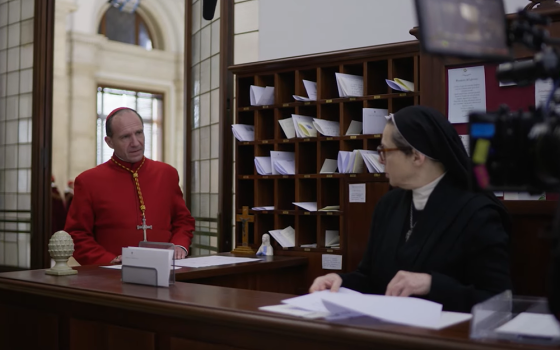Visitors to St. Peter's Square use their smartphones to read about the sculpture "Angels Unawares" by Canadian sculptor Timothy Schmalz Dec. 28, 2021. (CNS photo/Cindy Wooden)
A life-sized bronze sculpture of migrants and refugees crowded onto a boat has stood in St. Peter's Square for more than two years, but just before Christmas a small QR code was placed on the boat's stern to give onlookers information about the work.
The QR code allows people to use their smartphones to access a dedicated website, the Vatican said in a statement Dec. 29, shortly after Pope Francis had encouraged people at his general audience to pray for migrants and refugees.
"Migration today is a reality to which we cannot close our eyes," the pope said. "It is a social scandal of humanity."
Canadian sculptor Timothy Schmalz, well known also for his "Homeless Jesus" sculpture, created the piece in St. Peter's Square after a conversation in 2017 with Canadian Cardinal Michael Czerny, undersecretary of the Migrants and Refugees Section of the Vatican Dicastery for Promoting Integral Human Development, said the website linked by the QR code.
Advertisement
Schmalz titled the migrants' sculpture "Angels Unawares," citing Hebrews 13:2, which in one translation says, "Do not neglect to show hospitality to strangers, for thereby some have entertained angels unawares."
The website explains that the sculpture depicts "a group of migrants and refugees from different cultural and racial backgrounds and from diverse historic periods of time. They stand together, shoulder to shoulder, huddled on a raft. Within this diverse crowd of people, angel wings emerge from the center, suggesting the presence of the sacred among them."
With the small, unobtrusive QR code, visitors can choose to read about the sculpture in German, English, Spanish, French, Italian or Portuguese.
"We have decided to incorporate cultural information and church teachings from recent years to help all tourists and visitors at the Vatican to become pilgrims, too," Cardinal Czerny said in the news release. The aim of the QR code is to help visitors "appreciate the sculpture and pass to a deeper reading, helping raise awareness of the reality of human mobility throughout the ages that is artistically expressed," the statement said.







